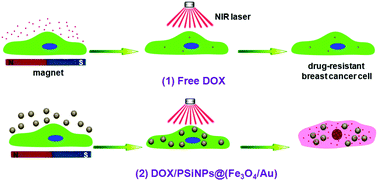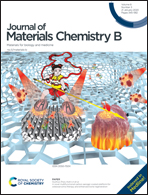Near-infrared light and magnetic field dual-responsive porous silicon-based nanocarriers to overcome multidrug resistance in breast cancer cells with enhanced efficiency†
Abstract
The development of drug delivery systems based on external stimuli-responsive nanocarriers is important to overcome multidrug resistance in breast cancer cells. Herein, iron oxide/gold (Fe3O4/Au) nanoparticles were first fabricated via a simple hydrothermal reaction, and subsequently loaded into porous silicon nanoparticles (PSiNPs) via electrostatic interactions to construct PSiNPs@(Fe3O4/Au) nanocomposites. The as-prepared PSiNPs@(Fe3O4/Au) nanocomposites exhibited excellent super-paramagnetism, photothermal effect, and T2-weight magnetic resonance imaging capability. In particular, with the help of a magnetic field, the cellular uptake of PSiNPs@(Fe3O4/Au) nanocomposites was significantly enhanced in drug-resistant breast cancer cells. Moreover, PSiNPs@(Fe3O4/Au) nanocomposites as carriers showed a high loading and NIR light-triggered release of anticancer drugs. Based on the synergistic effect of magnetic field-enhanced cellular uptake and NIR light-triggered intracellular release, the amount of anticancer drug carried by PSiNPs@(Fe3O4/Au) nanocarriers into the nuclei of drug-resistant breast cancer cells sharply increased, accompanied by improved chemo-photothermal therapeutic efficacy. Finally, PSiNPs@(Fe3O4/Au) nanocomposites under the combined conditions of magnetic field attraction and NIR light irradiation also showed improved anticancer drug penetration and accumulation in three-dimensional multicellular spheroids composed of drug-resistant breast cancer cells, leading to a better growth inhibition effect. Overall, the fabricated PSiNPs@(Fe3O4/Au) nanocomposites demonstrated great potential for the therapy of multidrug-resistant breast cancer in future.



 Please wait while we load your content...
Please wait while we load your content...